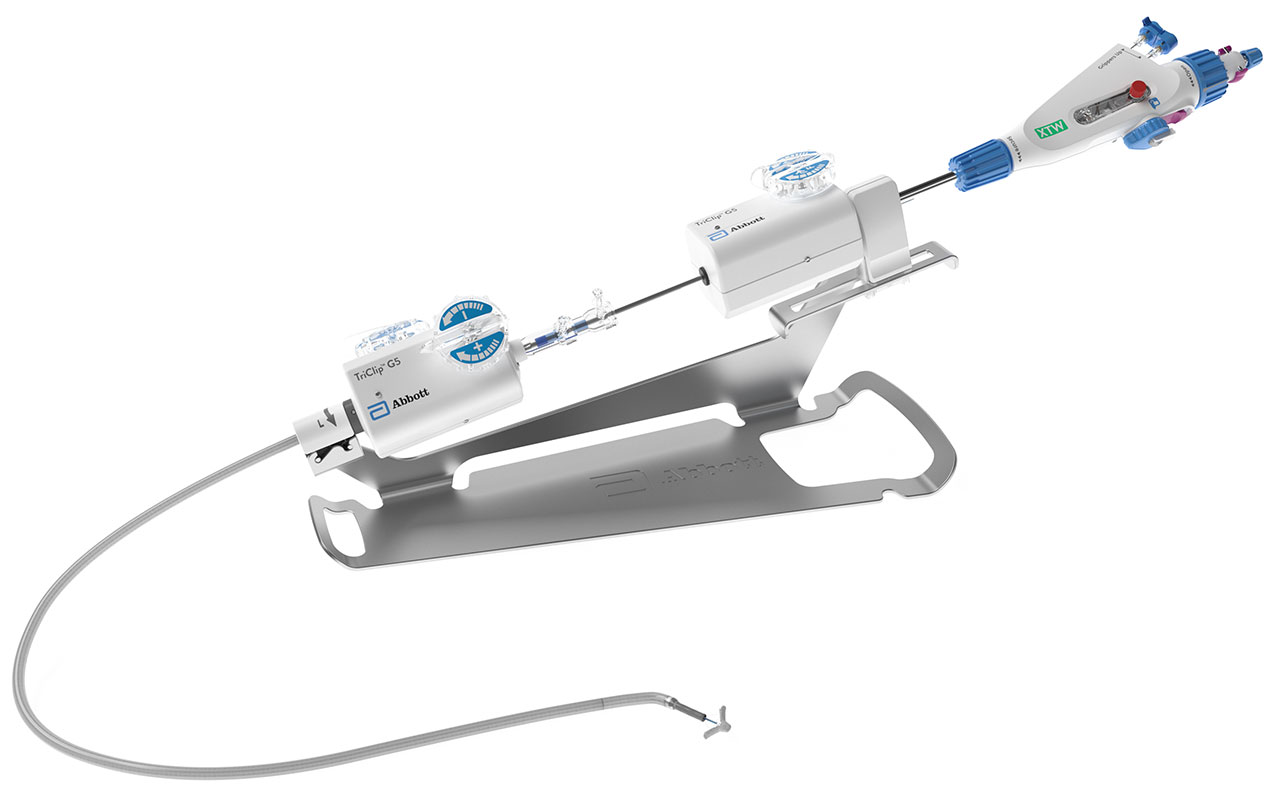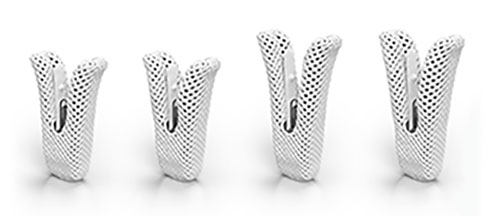The Standard of Caring for TR
The TriClip™ G5 System offers a minimally invasive treatment option for improving quality of life and functional status in patients with symptomatic severe tricuspid regurgitation, despite optimal medical therapy, who are at intermediate or greater risk for surgery and in whom transcatheter edge-to-edge valve repair is clinically appropriate.
Exceptional Safety1,2
- Catheter designed for stability and control when navigating and crossing the valve3,4
- Retaining forces are distributed across the frictional elements minimizing the risk of leaflet protrusion*5,6
- Low risk of intra- and post-procedural adverse events at 30 Days7,8
- Little to no risk of pacing or required adjunct therapies5,7
Maximized Effectiveness9,10
- Anatomically designed for the height you need for direct access to the valve*3,6
- Multi-axis steering enables you to navigate across all lines of coaptation while maintaining perpendicularity to the valve plane*3,6
- Designed for deepest leaflet insertion to optimize leaflet coaptation and ensure leaflet retention during closure*11
Life-changing Impact
Improvement of 15 points in the KCCQ-OS reported in more than 50% of patients at 2 years in randomized study9, and an average of 19 points increase in the KCCQ-OS in the real world study at 1 year2
TriClip G5 Delivery System
Control Meets Efficiency

Clinical Outcomes
Remarkable TR Reduction9
Data from Triluminate™ Pivotal demonstrates that 84% of patients achieve TR moderate or less at 2 years9
Exceptional Benefits to Risk Profile1
- 98.9% Freedom from MAEs at 30 days
- 99.6% Freedom from Cardiovascular Mortality
- 0.9% New Pacemaker Rate at 30 days12
- 0% Thrombosis at 30 days
Meaningful Results1,2,9,10
TriClip TEER demonstrated to be superior to medical therapy alone in reducing Heart Failure Hospitalization (HFH) risk and improving Quality of Life (QOL).1,9
Learn more about TriClip TEER by visiting the Abbott Structural Heart website.
Ordering Information
TriClip G5 TEER System
| Product Code | Description | Piece Count |
|---|---|---|
| TCG50100 | TriClip G5 System | 1 |
| TCDS0801-NT | TriClip G5 NT Delivery System | 1 |
| TCDS0801-NTW | TriClip G5 NTW Delivery System | 1 |
| TCDS0801-XT | TriClip G5 XT Delivery System | 1 |
| TCDS0801-XTW | TriClip G5 XTW Delivery System | 1 |
| TSGC0801 | TriClip G5 Steerable Guide Catheter | 1 |
TriClip G5 Required Accessories
| Product Code | Description | Piece Count |
|---|---|---|
| SZR08 | Stabilizer | 1 |
| LFT07 | Lift | 1 |
| PLT07 | Support Plate | 1 |
TriClip G4 TEER System
| Product Code | Description | Piece Count |
|---|---|---|
| TCG40100 | TriClip G4 System | 1 |
| TCDS0301-NT | TriClip G4 NT Delivery System | 1 |
| TCDS0301-NTW | TriClip G4 NTW Delivery System | 1 |
| TCDS0301-XT | TriClip G4 XT Delivery System | 1 |
| TCDS0301-XTW | TriClip G4 XTW Delivery System | 1 |
| TSGC0201 | TriClip G4 Steerable Guide Catheter | 1 |
TriClip G4 Required Accessories - Other Countries (excluding U.S.)
| Product Code | Description | Piece Count |
|---|---|---|
| SZR07 | Stabilizer | 1 |
| LFT07 | Lift | 1 |
| PLT07 | Support Plate | 1 |
Europe, Middle East, and Africa
TriClip G4 System - EU MDR
| Product Code | Description | Piece Count |
|---|---|---|
| TC0307-NT | TriClip GT NT bundle [Content: one (1) TCDS0307-NT, one (1) TSGC0207] | 2 |
| TC0307-NTW | TriClip G4 NTW bundle (Contents: one (1) TCDS0307-NTW, one (1) TSGC0207] | 2 |
| TC0307-XT | TriClip G4 XT bundle [Contents: one(1) TCDS0307-XT, one (1) TSGC0207] | 2 |
| TC0307-XTW | TriClip G4 XTW bundle [Contents: one (1) TCDS0307-XTW, one (1) TSGC0207] | 2 |
| TCDS0307-NT | TriClip G4 NT Delivery System | 1 |
| TCDS0307-NTW | TriClip G4 NTW Clip Delivery System | 1 |
| TCDS0307-XT | TriClip G4 XT Delivery System | 1 |
| TCDS0307-XTW | TriClip G4 XTW Delivery System | 1 |
| TSGC0207 | TriClip Steerable Guide Catheter | 1 |
Required Accessories
| Product Code | Description | Piece Count |
|---|---|---|
| SZR07 | Stabilizer | 1 |
| LFT07 | Lift | 1 |
| PLT07 | Support Plate | 1 |

References
- Tang GHL, Hahn RT, Whisenant BK, et al. Tricuspid transcatheter edge-to-edge repair for severe tricuspid regurgitation: 1-year outcomes from the TRILUMINATE randomized cohort. J Am Coll Cardiol. Published online 2025;85(3):235-246. doi:10.1016/j.jacc.2024.10.08
- Lurz P, Rommel KP, Schmitz T, et al. Real-world 1-year results of tricuspid edge-to-edge repair from the bRIGHT study. J Am Coll Cardiol. 2024;84(7):607-616. doi:10.1016/j.jacc.2024.05.006
- Test(s) performed by and data on file at Abbott. (RPT2118537)
- Test(s) performed by and data on file at Abbott. (RPT2105461-R)
- Test(s) performed by and data on file at Abbott. (RPT2122822-R)
- Test(s) performed by and data on file at Abbott. (RPT2124838-R)
- Sorajja P, Whisenant B, Hamid N, et al. Transcatheter repair for patients with tricuspid regurgitation. N Engl J Med. 2023;388(20):1833-1842. doi:10.1056/NEJMoa2300525.
- Adams D, Sorajja P, et al. TRILUMINATE Pivotal: Outcomes of All Randomized and Single-arm Subjects with Transcatheter Tricuspid Valve Edge-to-Edge Repair for Tricuspid Regurgitation. Presented at TCT on October 24, 2023; San Francisco, CA; USA.
- Kar S, Makkar RR, Whisenant BK, et al. Two-year outcomes of transcatheter edge-to-edge repair for severe tricuspid regurgitation: The TRILUMINATE Pivotal Randomized Trial. Circulation. March 30, 2025. doi:10.1161/CIRCULATIONAHA.125.074536
- Estevez-Loureiro, R., Real-world outcomes for tricuspid edge-to-edge repair: initial 2-year outcomes from the bRIGHT trial. Presented at PCR London Valves; November 19, 2023; London, England.
- Von Bardeleben RS, Lurz P, Sitges M, et al. Percutaneous edge-to-edge repair for tricuspid regurgitation: 2-year outcomes from the TRILUMINATE trial. Presented at: EuroPCR; May 18-20, 2021; Paris, France.
- Kar, S., et al. Two-year Outcomes of Transcatheter Edge-to-edge Repair for Severe Tricuspid Regurgitation: The TRILUMINATE Pivotal Randomized Trial. Circulation. March 30, 2025. March 30, 2025. Suppl 1. Table 7 doi:10.1161/CIRCULATIONAHA.125.000000
MAT-2513222 v1.0
Rx Only
Important Safety Information
TRICLIP™ CLIP G5 SYSTEM
INDICATIONS
The TriClip™ G5 System is indicated for improving quality of life and functional status in patients with symptomatic severe tricuspid regurgitation despite optimal medical therapy, who are at intermediate or greater risk for surgery and in whom transcatheter edge-to-edge valve repair is clinically appropriate and is expected to reduce tricuspid regurgitation severity to moderate or less, as determined by a multidisciplinary heart team.
CONTRAINDICATIONS
The TriClip™ G5 System is contraindicated for use in patients with the following conditions: Intolerance, including allergy or untreatable hypersensitivity, to procedural anticoagulation; Untreatable hypersensitivity to Implant components (nickel-titanium alloy, cobalt-chromium alloy); Active endocarditis or other active infection of the tricuspid valve.
POTENTIAL ADVERSE EVENTS
The following events have been identified as possible complications of the TriClip™ G5 Procedure. Allergic reactions or hypersensitivity to latex, contrast agent, anaesthesia, device materials and drug reactions to anticoagulation, or antiplatelet drugs; Additional treatment / surgery from device-related complications; Bleeding; Blood disorders (including coagulopathy, hemolysis, and Heparin Induced Thrombocytopenia (HIT)); Cardiac arrhythmias (including conduction disorders, atrial arrhythmias, ventricular arrhythmias); Cardiac ischemic conditions (including myocardial infarction, myocardial ischemia, unstable angina, and stable angina); Cardiac perforation; Cardiac tamponade; Chest pain; Death; Dyspnea; Edema; Embolization (device or components of the device); Endocarditis; Fever or hyperthermia; Fluoroscopy and Transesophageal echocardiogram (TEE) -related complications: Skin injury or tissue changes due to exposure to ionizing radiation, Esophageal irritation, Esophageal perforation, Gastrointestinal bleeding; Hypotension / hypertension; Infection including: Septicemia; Nausea or vomiting; Pain; Pericardial effusion; Stroke / cerebrovascular accident (CVA) and transient ischemic attack (TIA); System organ failure: Cardio-respiratory arrest, Worsening heart failure, Pulmonary congestion, Respiratory dysfunction or failure or atelectasis, Renal insufficiency or failure, Shock (including cardiogenic and anaphylactic); Thrombosis; Tricuspid valve complications, which may complicate or prevent later surgical repair, including: Chordal entanglement / rupture, Single leaflet device attachment (SLDA), Dislodgement of previously implanted devices, Tissue damage, Tricuspid valve stenosis, Worsening, persistent or residual regurgitation; Vascular access complications which may require additional intervention, including: Wound dehiscence, Bleeding of the access site, Arteriovenous fistula, pseudoaneurysm, aneurysm, dissection, perforation (rupture), vascular occlusion, Embolism (air, thrombus), Peripheral nerve injury; Venous thrombosis (including deep vein thrombosis) and thromboembolism (including pulmonary embolism).
Rx Only
Important Safety Information
TRICLIP™ CLIP G4 SYSTEM
INDICATIONS
The TriClip™ G4 System is indicated for improving quality of life and functional status in patients with symptomatic severe tricuspid regurgitation despite optimal medical therapy, who are at intermediate or greater risk for surgery and in whom transcatheter edge-to-edge valve repair is clinically appropriate and is expected to reduce tricuspid regurgitation severity to moderate or less, as determined by a multidisciplinary heart team.
CONTRAINDICATIONS
The TriClip G4 System is contraindicated in patients with the following conditions: Intolerance, including allergy or untreatable hypersensitivity, to procedural anticoagulation; Untreatable hypersensitivity to Implant components (nickel-titanium alloy, cobalt-chromium alloy); Active endocarditis or other active infection of the tricuspid valve.
POTENTIAL ADVERSE EVENTS
The following events have been identified as possible complications of the TriClip G4 Procedure. Allergic reactions or hypersensitivity to latex, contrast agent, anaesthesia, device materials and drug reactions to anticoagulation, or antiplatelet drugs; Additional treatment/surgery from device-related complications; Bleeding; Blood disorders (including coagulopathy, hemolysis, and heparin induced thrombocytopenia (HIT)); Cardiac arrhythmias (including conduction disorders, atrial arrhythmias, ventricular arrhythmias); Cardiac ischemic conditions (including myocardial infarction, myocardial ischemia, unstable angina, and stable angina); Cardiac perforation; Cardiac tamponade; Chest pain; Death; Dyspnea; Edema; Embolization (device or components of the device); Endocarditis; Fever or hyperthermia; Fluoroscopy and transesophageal echocardiogram (TEE) related complications: Skin injury or tissue changes due to exposure to ionizing radiation, Esophageal irritation, Esophageal perforation, Gastrointestinal bleeding; Hypotension/hypertension; Infection including: Septicemia; Nausea or vomiting; Pain; Pericardial effusion; Stroke/cerebrovascular accident (CVA) and transient ischemic attack (TIA); System organ failure: Cardio-respiratory arrest, Worsening heart failure, Pulmonary congestion, Respiratory dysfunction or failure or atelectasis, Renal insufficiency or failure, Shock (including cardiogenic and anaphylactic); Thrombosis; Tricuspid valve complications, which may complicate or prevent later surgical repair, including: Chordal entanglement/rupture, Single leaflet device attachment (SLDA), Dislodgement of previously implanted devices, Tissue damage, Tricuspid valve stenosis, Worsening, persistent or residual regurgitation; Vascular access complications which may require additional intervention, including: Wound dehiscence, Bleeding of the access site, Arteriovenous fistula pseudoaneurysm, aneurysm, dissection, perforation (rupture), vascular occlusion, Embolism (air, thrombus), Peripheral nerve injury; Venous thrombosis (including deep vein thrombosis) and thromboembolism (including pulmonary embolism).
